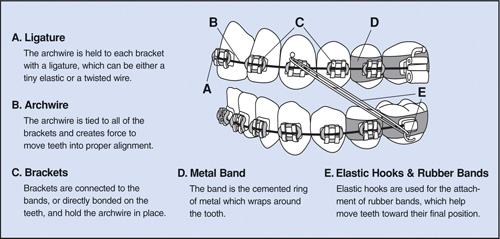Emergency!! or is it?
As a patient, parent, sibling or school nurse, you will occasionally face an orthodontic emergency. Most orthodontic emergencies, though a little upsetting to the patient, are actually fairly simple to treat. In most cases, with the right tools and a little “tender loving care,” the Patient will be able to return to normal activities, with no discomfort for the remainder of the day. Please make sure to always contact our office with ANY abnormalities to your orthodontic equipment.
For some emergencies, you may need to contact our office. To help you accurately describe an emergency situation to us, use the diagram below, which illustrates and names each part of a typical set of braces.

Tools & Supplies
With these tools and supplies on hand in your clinic (most of which you already have), you will be prepared to handle the most common orthodontic emergencies.
* Non-medicated orthodontic relief wax
* Dental floss
* Sterile tweezers
* Small, sharp clipper
* Q-tips
* Salt
* Interproximal brush
* Toothpicks
* Non-prescription pain reliever (acetaminophen or ibuprofen supplied by the patient’s parent/guardian—use only with written permission of the orthodontist and parent/guardian)
* Topical Anesthetic (such as Orabase or Ora-Gel)
Food Caught Between Teeth
This is not an emergency, but can be a little uncomfortable or embarrassing for the braces-wearing patient. It is easily fixed with a piece of dental floss. Try tying a small knot in the middle of the floss to help remove the food. Or use an interproximal brush or toothpick to dislodge food caught between teeth and braces.
Lost Wire or Ligature
Tiny rubber bands or small, fine wires, known as ligatures, hold the wire to the bracket. If a rubber or wire ligature is lost, notify the parents so that the orthodontist may advise whether the patient should be seen.
Ligatures Come Off
If a rubber ligature should come off, you may be able to put it back in place using sterile tweezers. If a wire ligature comes loose, simply remove it with sterile tweezers. If the wire ligature is sticking out into the lip but is not loose, it may be bent back down with a Q-tip or pencil eraser to eliminate the irritation.
Of course, when one ligature pops off or breaks, others may follow. Be sure to examine all ligatures before returning to regular activities. Missing or broken ligatures should be brought to the attention of our office.
Discomfort
It’s normal for a patient to have discomfort for a day or two after braces or retainers are adjusted. But it can make eating uncomfortable. Reassure the patient that the discomfort is both normal and temporary. Encourage soft foods. Have the patient rinse the mouth with warm salt water. If the patient is allowed to have over-the-counter pain relievers, acetaminophen or ibuprofen may be effective.
Mouth Sores
Some patients are susceptible to episodes of mouth sores. While braces do not cause them, they may be precipitated or exacerbated by an irritation from braces. One or several areas of ulceration of the cheeks, lips or tongue may appear. This is not an emergency, but may be very uncomfortable for the patient. Prompt relief may be achieved by applying a small amount of topical anesthetic (such as Orabase or Ora-Gel) directly to the ulcerated surface using a cotton swab. Reapply as needed.
Irritation in Mouth
Sometimes new braces can be irritating to the mouth, especially when the patient is eating. A small amount of non-medicinal relief wax makes an excellent buffer between metal and mouth. Simply pinch off a small piece and roll it into a ball the size of a small pea. Flatten the ball and place it completely over the area of the braces causing irritation. The patient may then eat food more comfortably. If wax is accidentally ingested it’s not a problem. The wax is harmless.
Protruding Wire
Occasionally the end of a wire will work itself out of place and irritate the patient’s mouth. Use a Q-tip or pencil eraser to push the wire so that it is flat against the tooth. If the wire cannot be moved into a comfortable position, cover it with relief wax. (See Irritation of Cheeks or Lips above for instructions on applying relief wax.) The patient’s will need to make the orthodontist aware of the problem.
In a situation where the wire is extremely bothersome and the patient will not be able to see the Dr. anytime soon, as a last resort, you may clip the wire.
Reduce the possibility of the patient swallowing the snipped piece of wire by using folded tissue or gauze around the area. Use a pair of sharp clippers and snip off the protruding wire. Relief wax may still be necessary to provide comfort to the irritated area.
Loose Wires, Brackets, Bonds or Bands
If the braces have come loose in any way, the parents need to be notified, and they should call the office to determine appropriate next steps.
A Bracket is Knocked Off
Brackets are the parts of braces attached to teeth with a special adhesive. They are generally positioned in the center of each tooth. The bracket can be knocked off if the patient has eaten one of those hard or crunchy foods orthodontic patients are instructed to avoid, or if the mouth is struck while at play. (Encourage all patients, especially those with braces, to wear a protective mouth guard while playing sports.)
If the bracket is off center, the adhesive may have failed. Notify the orthodontist, who will determine the course of action.